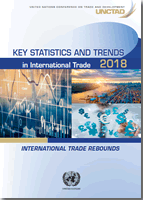
International trade patterns of the last few years have been characterized first by anaemic growth (2012- 2014), then by a downturn (2015 and 2016) and finally by a strong rebound (2017 and 2018).
From 2012 to 2014 the value of international trade grew at a rate of less than 2 per cent per year, declined by 10 per cent in 2015, and by about 3 per cent in 2016. It then rebounded strongly, growing at 10 per cent in 2017. Preliminary data for 2018 indicate an even higher growth rate.
The recovery in international trade in the last two years was in part due to nominal factors and in part to increase in volumes. In particular, the price of commodities regained ground and the United States dollar depreciated in real terms against a basket of currencies. Stronger global output growth and investment also played a role.
Trade growth of last two years has been widespread to include most goods and services sectors.
Merchandise trade has shown a particularly strong rebound after it dropped significantly in 2015-2016.
Services trade fared better during those years, and the recovery was also more gradual.
Trade in natural resources showed the strongest value growth in 2017 because of higher commodity prices.
The trade surge of 2017 also affected positively all geographic regions. South–South trade has recovered as well, although it remains below its 2014 levels.
This report is structured into two parts.
The first part presents an overview of the status of international trade using statistics up to 2018.
The second part provides illustrative statistics on international trade in goods and services covering the last decade. The second part is divided into two sections.
- Section 1 provides trade statistics at various levels of aggregation illustrating the evolution of trade across economic sectors and geographic regions.
- Section 2 presents some of the most commonly used trade indicators at the country level, so as to illustrate trade performance across countries.



